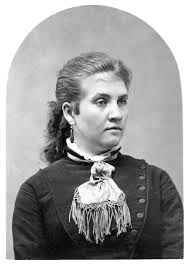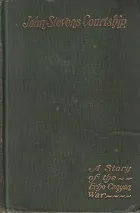 Natalie Brown introduces her critical edition of John Stevens’ Courtship, by Susa Young Gates, published this month by BCC Press.
Natalie Brown introduces her critical edition of John Stevens’ Courtship, by Susa Young Gates, published this month by BCC Press.
Shortly after graduating with a PhD in English and Comparative literature, I realized that I had never read a novel by someone from my own Mormon culture in an academic setting. I had read plenty of books about Mormons, most of which sensationalized polygamy or reduced Mormons to naive or sinister stereotypes. But not ones by Mormons. I wanted to correct the deficiency in my education, so I began reading novels by latter-day saints. It wasn’t easy. Most older novels were simply unavailable in easy-to-access, high-quality editions.
 The BCC Press edition of Susa Young Gates’ John Stevens’ Courtship is part of an effort to make literature by Mormons readily available. Born in 1856 to President Brigham Young of the Church of Jesus Christ of Latter-day Saints and his plural wife Lucy Bigelow, Gates became one of the most prominent Mormon voices of her generation. After serving a mission in Hawaii, she founded both the Young Woman’s Journal (1889) and the Relief Society Bulletin (1914). She advocated for women’s opportunities and suffrage, establishing friendships with luminaries such as Susan B. Anthony and Charlotte Perkins Gilman. She was also heavily involved in genealogy.
The BCC Press edition of Susa Young Gates’ John Stevens’ Courtship is part of an effort to make literature by Mormons readily available. Born in 1856 to President Brigham Young of the Church of Jesus Christ of Latter-day Saints and his plural wife Lucy Bigelow, Gates became one of the most prominent Mormon voices of her generation. After serving a mission in Hawaii, she founded both the Young Woman’s Journal (1889) and the Relief Society Bulletin (1914). She advocated for women’s opportunities and suffrage, establishing friendships with luminaries such as Susan B. Anthony and Charlotte Perkins Gilman. She was also heavily involved in genealogy.
Although Gates was undoubtedly more privileged than other latter-day saint women of her era, the scope of her work can be startling to modern readers more accustomed to thinking of latter-day saint women as confined to the home. The more I learned about Gates, the more I wanted to know why the roles of latter-day saint women had changed between her lifetime and mine in ways that felt constricting. As I read her most famous novel, John Stevens’ Courtship, I realized that Gates herself played a pivotal role in shaping a new domestic narrative for latter-saint women after the church ended polygamy in 1890 in response to federal pressure. It was also a narrative about which she was ambivalent.
 John Stevens’ Courtship tells the story of a love triangle between a latter-day saint man and two latter-day saint women during the federal occupation of Utah. Gates penned the first edition of the novel and serialized it in The Contributor between 1895 and 1896. She later substantially revised and republished it in 1909. Most notably, the 1909 edition largely erases the earlier novel’s references to polygamy, probably reflecting the church’s increased need to put the practice in the past.
John Stevens’ Courtship tells the story of a love triangle between a latter-day saint man and two latter-day saint women during the federal occupation of Utah. Gates penned the first edition of the novel and serialized it in The Contributor between 1895 and 1896. She later substantially revised and republished it in 1909. Most notably, the 1909 edition largely erases the earlier novel’s references to polygamy, probably reflecting the church’s increased need to put the practice in the past.
At the time in which Gates wrote, the church was transitioning into a post-polygamy society and struggling to more fully integrate into the United States. Although many welcomed the end of polygamy, Gates worried about what would happen to latter-day saint women who no longer had the opportunity to marry (and presumably also about the women in polygamous marriages who had suddenly lost their homes). The church’s shift from a communitarian society to a cash society more economically enmeshed with the United States was also reducing latter-day saint women’s economic power.
Scholars have smartly observed how John Stevens’ Courtship helps rebrand Mormon romance as focused on monogamy and eternal companionship rather than polygamy. It deploys widely accepted domestic tropes to bring the Mormon marriage plot more comfortably within the greater American culture. BCC Press’s edition of John Stevens’ Courtship incorporates both the 1895-1896 and 1909 versions, however, so that readers can also more clearly see Gates’ awareness that the end of polygamy came with high costs to many latter-day saint women. What happens, the novel asks, when a love triangle can no longer be resolved by polygamy and there’s a shortage of latter-day saint men? The novel also fashions a patriotic narrative of Mormonism and likely depicts (albeit in racist terms) the first black character in fiction by a latter-day saint.
While an uneven novel by today’s standards, John Stevens’ Courtship is essential reading for anyone interested in how Mormonism transitioned from polygamy to monogamy—and perhaps inadvertently reduced some women’s economic opportunities in the process.
Susa Gates Young. John Stevens’ Courtship: A Story of the Echo Canyon War. Critical Education edited by Natalie Brown. BCC Press, October 2024.
Natalie Brown holds a PhD in English and Comparative literature from Columbia University. Her writing regularly appears in The Salt Lake Tribune and at By Common Consent. She is editor of BCC Press’s John Stevens’ Courtship. She is writing in her personal capacity, and her views do not necessarily reflect those of the church, her employer, or BCC Press.
